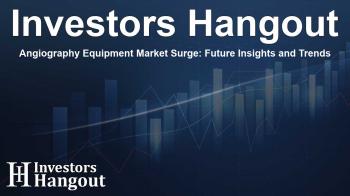Angiography Equipment Market Surge: Future Insights and Trends

Understanding the Growth of the Angiography Equipment Market
The angiography equipment market has shown remarkable growth recently. In 2023, it was valued at approximately USD 10.53 billion and is poised to reach around USD 17.92 billion by 2032. This significant increase points toward a compound annual growth rate (CAGR) of 6.11% from 2024 to 2032. The increase in cardiovascular diseases is a central factor driving this market forward, along with advancements in imaging technologies.
Key Drivers Behind Market Growth
The primary factors contributing to the growth of the angiography equipment sector include the escalating rates of cardiovascular diseases worldwide, which demand effective diagnostic tools. As healthcare continues to evolve, there is a growing preference for minimally invasive procedures. This shift is further facilitated by technological advancements in imaging solutions, such as the integration of artificial intelligence and specialized catheter systems that enhance accuracy and efficiency in diagnostics.
Rising Demand for Advanced Imaging Technologies
Technological innovations enhance both diagnostic accuracy and procedural efficiency in angiography, making it a crucial component of modern healthcare. The geriatric population is increasing, leading to higher instances of health conditions requiring angiography. Coupled with significant investments in healthcare infrastructure globally, these trends support the market's upward trajectory.
Regional Insights: A Snapshot of Market Dynamics
The angiography equipment market in the United States is particularly noteworthy. With a market valuation of USD 3.54 billion in 2023 projected to grow to USD 5.73 billion by 2032, the United States clearly showcases significant demand due to its advanced healthcare infrastructure and high spending on medical technologies. This is complemented by a rapid adoption of sophisticated imaging technologies that bolster the market.
Notable Companies Shaping the Market
Several key players are recognized for their contributions to the angiography equipment market. Companies like Siemens Healthineers and GE Healthcare lead with state-of-the-art imaging systems. Other notable firms include Philips Healthcare and Boston Scientific, establishing their presence with innovative products centered around angiography.
Segment Analysis: Technologies and Procedures
Within the angiography equipment market, differing segments reveal diverse trends. The angiography systems segment has dominated, capturing a 22.90% market share in 2023. Notably, this segment remains central to cardiovascular diagnostics and interventions, addressing the ongoing need for precise imaging in clinical settings.
Emerging Growth Areas in Contrast Media
On the other hand, the contrast media segment is anticipated to witness the fastest growth due to the increasing reliance on these agents in angiographic procedures. Enhanced vascular visualization is paramount for accurate diagnoses, driving demand for innovative contrast agents.
The Technological Edge: Dominance of X-ray Systems
X-ray technology continues to hold a significant share in the angiography equipment market as of 2023, owing to its low cost of operation and high resolution for vascular imaging. This technology remains vital for accurate diagnostics and intervention, especially in guiding catheters and stents effectively.
Coronary Angiography: A Market Leader
Coronary angiography stands out as the leading procedure in this market, propelled by the high prevalence of coronary artery disease. Continuous advancements in imaging technology further drive the applicability and accuracy of coronary diagnostics, enhancing market dominance.
Future Trends and Market Projections
The market is expected to maintain momentum, especially in regions like Asia Pacific, where healthcare infrastructure is rapidly developing. Nations like India and China are experiencing surging demands for angiographic procedures alongside substantial healthcare investments.
Frequently Asked Questions
What is the expected growth of the angiography equipment market?
The angiography equipment market is anticipated to grow from USD 10.53 billion in 2023 to USD 17.92 billion by 2032.
Which factors are driving this market growth?
Key drivers include increasing cardiovascular diseases, technological advancements in imaging, and a growing geriatric population.
How does the U.S. market compare to other regions?
The U.S. angiography equipment market is the largest regionally, characterized by high healthcare expenditures and rapid adoption of new technologies.
What role do technological advancements play?
Technological innovations significantly enhance diagnostic accuracy and procedural efficiency, making angiography essential in modern healthcare.
Which companies are leading in angiography equipment?
Leading companies include Siemens Healthineers, GE Healthcare, and Philips Healthcare, known for their key advancements in angiography systems.
About The Author
Contact Evelyn Baker privately here. Or send an email with ATTN: Evelyn Baker as the subject to contact@investorshangout.com.
About Investors Hangout
Investors Hangout is a leading online stock forum for financial discussion and learning, offering a wide range of free tools and resources. It draws in traders of all levels, who exchange market knowledge, investigate trading tactics, and keep an eye on industry developments in real time. Featuring financial articles, stock message boards, quotes, charts, company profiles, and live news updates. Through cooperative learning and a wealth of informational resources, it helps users from novices creating their first portfolios to experts honing their techniques. Join Investors Hangout today: https://investorshangout.com/
The content of this article is based on factual, publicly available information and does not represent legal, financial, or investment advice. Investors Hangout does not offer financial advice, and the author is not a licensed financial advisor. Consult a qualified advisor before making any financial or investment decisions based on this article. This article should not be considered advice to purchase, sell, or hold any securities or other investments. If any of the material provided here is inaccurate, please contact us for corrections.

